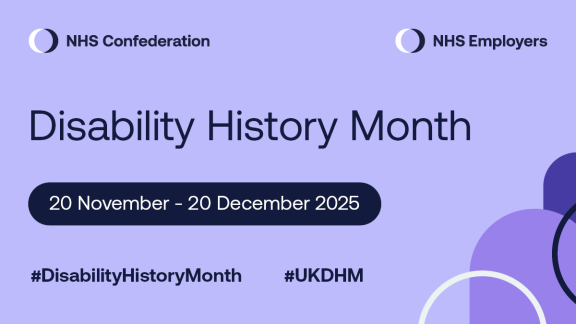
About the Equality, Diversity and Inclusion Group
The Equality, Diversity and Inclusion Group (EDIG) is a national technical group of the NHS Staff Council and works to deliver the equality agenda.
The group comprises of employer and trade union representatives from across the NHS. EDIG works in partnership and prepares an annual work programme which is agreed by the executive of the NHS Staff Council. This includes producing our own guidance, reviewing sections of the NHS Terms and Conditions of Service Handbook and reviewing and contributing to other work carried out by the Staff Council.
EDIG is chaired in partnership by a staff-side and management side representative.
Introduction
The aim of this guidance is to help employers understand their statutory duties under the Equality Act 2010 (the Act). This means removing the barriers that deny disabled people equality of outcome in the workplace. The guidance supports staff, line managers, trade union representatives and staff networks. It includes suggestions and examples of good practice that will help employers create the best working environment in which disabled people are able to reach their full potential.
The social model of disability says that people are disabled by barriers in society, not by their impairment or difference. When an organisation has taken on the social model it should guide all its work to remove these barriers and improve life for disabled people. Not everyone uses the language of the social model and it is important to listen to the individual and their own experience. Most disabilities (70-80 per cent) are not visible and the impact they have can fluctuate, for example, long COVID, mental health conditions, multiple sclerosis and fibromyalgia.
Why is this important
The NHS Workforce Disability Equality Standard (WDES) is a mandated collection of ten metrics that NHS employers use to compare the workplace and career experiences of disabled and non-disabled staff. Through these metrics, employers can take an evidence-based approach to developing actions to improve these experiences.
In June 2023, NHS England published its equality, diversity and inclusion improvement plan, which is centred around six high impact actions. Five of these directly impact disabled staff:
- Ensure chief executives, chairs and board members have specific and measurable equality, diversity and inclusivity (EDI) objectives to which they will be individually and collectively accountable. This aims to ensure collective leadership and accountability at board level. This could also tackle the lack of data which remains an issue. The Electronic Staff Record (ESR) system shows that just 4.9 per cent of staff identify as disabled. However, the anonymised NHS Staff Survey shows that nearly 1 in 4 NHS staff state they are disabled. Evidence shows that fear of being treated differently and having fewer opportunities to progress at work create barriers to disclosing a disability.
- Embed fair and inclusive recruitment processes and talent management strategies that target under-representation and lack of diversity. The WDES report published in 2024, which shows analysis of data collected in 2023, illustrated that just over half (52.1 per cent) of disabled staff believed they had equal opportunities for career progression or promotion.
- Develop and implement an improvement plan to eliminate pay gaps, including addressing the disability pay gap. Data from the Office for National Statistics shows that in 2021 there was a 13.8 per cent disability pay gap.
- Develop and implement an improvement plan to address health inequalities within the workforce. The WDES 2023 national report showed that only 73.4 per cent of disabled staff report that they have received the adjustments necessary to perform their duties effectively.
- Create an environment that eliminates the conditions in which bullying, discrimination, harassment and physical violence at work occur. Removing discrimination and ensuring that the NHS is a truly inclusive place to work must be a key priority. 33.2 per cent of disabled staff reported having experienced bullying, harassment or abuse from patients, service users or the public, with 24.8 per cent reporting it from colleagues.
The NHS staff survey also shows that disabled staff feel more pressured, compared to non-disabled staff, to be at work even when they do not feel well and have fewer opportunities for flexible working patterns. This may lead to presenteeism and could have an adverse effect on an individual’s health, recovery, mental health and wellbeing. Flexible working supports a better work life balance and improved wellbeing. It also improves productivity, increases staff retention and provides better recruitment.
What are the legal requirements for employers?
The Act derives from the EU Equal Treatment Framework Directive and protects people with protected characteristics (which includes disability) from discrimination in the workplace and in wider society. It replaced previous anti-discrimination laws with a single Act, making the law easier to understand and strengthening protection in some areas. It sets out the different ways in which it is unlawful to treat someone and allows disabled people to be treated more favourably than non-disabled people, in some scenarios. Understanding this, and the reasons for it, is crucial to removing the barriers that continue to deny disabled people equity.
The Public Sector Equality Duty places obligations on public sector bodies to act proactively. The Duty requires public bodies to have due regard to the need to:
- eliminate discrimination, harassment and victimisation and other conduct prohibited by the Act
- advance equality of opportunity between people from different groups
- foster good relations between people from different groups.
The UK is also a signatory of the United Nations Convention on the Rights of Persons with Disabilities. The Convention prohibits discrimination on the basis of disability with regard to all matters concerning employment. This includes conditions of recruitment, hiring and employment, continuance of employment, career advancement and safe and healthy working conditions. The Convention creates no direct obligations in UK domestic law (or freestanding rights for individuals) but may be relied on as an interpretative aid to construction of UK law.
The Act defines a disabled person as:
“... someone who has a mental or physical impairment that has a substantial and long-term adverse effect on the person’s ability to carry out normal day-to-day activities.”
Note that this is a legal rather than a medical test. This means that an individual is not required to have a medical diagnosis to be protected by the Act nor do they have to class themselves as disabled. This is especially pertinent for conditions like neurodiversity which can be difficult to get diagnosed (due to the difficulty accessing specialists with the necessary expertise) and where the employee may not consider themselves disabled. However, an employer cannot be liable for direct disability discrimination, discrimination arising from disability or failure to make reasonable adjustments unless it knew, or should have known, about the individual's disability.
It is worth noting, anyone who has HIV infection, cancer or multiple sclerosis is automatically treated as disabled under the Act. In addition, people who are registered as blind or partially sighted, or who are certified as being blind or partially sighted by a consultant ophthalmologist, are automatically treated under the Act as being disabled. People who are not registered or certified as blind or partially sighted will be covered by the Act if they can establish that they meet the Act’s definition of disability.
Additional information on the definition of disability is attached in Appendix A.
Part 5 of the Act protects disabled job applicants and those ‘in employment’ from disability discrimination, harassment, victimisation and any failure to comply with the duty to make reasonable adjustments. The protections apply to the following:
- application forms
- interview arrangements
- aptitude or proficiency tests
- job offers
- terms of employment, including pay
- promotion, transfer and training opportunities
- dismissal or redundancy
- disciplinaries and grievances.
Making reasonable adjustments
Under section 20 of the Equality Act 2010, an employer's duty to make reasonable adjustments arises where:
- a provision, criterion or practice applied by the employer, or,
- a physical feature of the employer’s premises, or,
- the employer not providing an auxiliary aid,
puts the disabled person at a substantial disadvantage in comparison with those who are not disabled. Here, the employer must take such steps as it is reasonable to take to either avoid the disadvantage or provide the auxiliary aid.
However, the duty to make reasonable adjustments will not arise unless the employer knows or ought reasonably to know of the disabled person's disability and that the disabled person is likely to be placed at a substantial disadvantage.
There is no obligation on the member of staff to request an adjustment. The duty on an employer to make reasonable adjustments arises automatically where a member of staff is disabled. It is also important to bear in mind that the onus is not on the disabled member of staff to suggest what adjustments should be made.
Employers should be able to demonstrate consideration of reasonable adjustments to working conditions, policies and practices that put a disabled member of staff at a disadvantage. A reasonable adjustment could include any of the following:
- making adjustments to premises
- acquiring and modifying equipment
- modifying instructions or reference manuals
- providing a reader or interpreter
- reallocating disabled employee's duties to another person
- providing supervision or other support
- transferring them to fill an existing suitable vacancy without competitive interview
- altering their working hours
- assigning them to a different place of work
- offering disability leave, allowing them to be absent during working hours for rehabilitation, assessment or treatment
- giving them, or arranging for them to be given, training or mentoring
- modifying procedures for testing or assessment
- employing a support worker
- modifying disciplinary or grievance procedures.
Employers should discuss the request with the disabled member of staff and must make adjustments that are reasonable. The employer should not make assumptions but consider carefully if the adjustment:
- will remove or reduce the disadvantage experienced by the disabled member of staff
- is practical to make
- is affordable (Access to Work funding should be considered, alongside alternatives and employers must make other workplace adjustments that are reasonable)
- could harm the health and safety of others.
If the adjustment requested is not considered reasonable, the employer should provide a detailed explanation of why and explore alternatives with the disabled member of staff.
Employers are advised to take steps to identify if reasonable adjustments are needed at the start of a recruitment process. This means when an applicant applies for a post and then at all stages of the employment cycle. This could include work trials or being sent the questions in advance, annual personal development reviews, return to work interviews and ensuring access to training. However, it must be noted that Section 60 of the Act states that employers must not ask about a job applicant’s health until that person has been either offered a job or been included in a pool of successful candidates to be offered a job. This provision will help prevent disabled candidates from being unfairly screened out at an early stage of the recruitment process.
In most circumstances, people who have had a disability in the past are protected from discrimination even if they have since recovered.
It is important to realise that the definition of disability considers the person as if they are without aid, support or medication (the exception being visual impairment that can be addressed by use of wearing prescription spectacles).
For healthcare students on clinical placements, the education partner should work with practice learning partners to ensure that reasonable adjustments are made. This should include to support disabled students to meet competency standards and ensure adjustments are made to learning environments to support them.
Discrimination by association or perception
As well as providing protection against discrimination and harassment due to a person’s disability, the Act provides protection from direct disability discrimination and harassment where this is based on a person’s association with a disabled person, or on a false perception that the person is disabled. This is of relevance to carers of disabled people (children or adults).
For example, a member of staff has a disabled child and they have had to take several days off when their child has a medical appointment related to their disability. The member of staff overhears their manager say that the child causes them to take an unacceptable amount of time off. The same manager then starts a performance management process with the member of staff despite no issues with their performance ever having been raised. This may amount to direct disability discrimination against the member of staff by association with their child.
Health and safety considerations
The Health and Safety at Work Act requires employers to protect all workers from the risk of injury or harm at work, so far as is reasonably practicable. This legislation shouldn’t prevent disabled people from finding or staying in employment. However, health and safety risks may mean that, in individual cases, a required adjustment is not reasonable and/or discrimination arising from disability or indirect discrimination is objectively justified.
To establish justification, an employer will need to show that there is a legitimate aim (a real business need) and that any policy, action or inaction by the employer is a proportionate means to achieving that aim (it is reasonably necessary to achieve that aim, and there are no less discriminatory means available). The employer must therefore go further than merely showing that it behaved reasonably, although it is not necessary to show that there were no other options open to it.
Under health and safety law, employers have a duty to assess the risks to the health and safety of employees while they are at work. Workplace risk assessments should be regularly reviewed including when an employer becomes aware that someone is disabled, to make sure that the assessment covers any risk to their health and safety.
The Health and Safety Executive states under employers' duties for protecting disabled workers:
“Disabilities can affect people in very individual ways and can often be supported through workplace adjustments so you should not make assumptions about disabled people or introduce blanket policies”.
A blanket policy would include banning all workers with the same health condition from doing tasks, despite the condition’s symptoms varying greatly in severity from person to person.
Practical ways to support disabled staff
This section covers what is deemed as good practice. NHS employers, in aiming to be employers of choice, will want to have regard for a number of good practice issues and initiatives in relation to disability in the workplace. Some key issues are outlined below.
Flexible working
In September 2021, new flexible working provisions agreed through the NHS Staff Council were introduced to the Agenda for Change Terms and Conditions of Service Handbook. Flexible working can include (but is not limited to) variations in working hours, fixed working patterns to give certainty over hours worked and/or location, compressed/elongated hours, average hours working patterns, flexible retirement, team self-rostering and homeworking for some or all the working patterns.
The key changes included:
- a new enhanced day one contractual right to request flexible working
- a revised structure aimed at supporting managers to be more explorative in reaching mutually workable outcomes
- an emphasis on the importance of monitoring flexible working requests at an organisational level, to ensure greater consistency of access to flexible working.
Alongside the new provisions, the NHS Staff Council published guidance which included information from EDIG on equality assessing and monitoring the changes.
The Employment Relations (Flexible Working) Act 2023 is due to come into force in 2024 and will make the following changes to the existing right to request flexible working rules contained in the Employment Rights Act 1996:
- Employers must consult with the employee before rejecting their flexible working request.
- Employees can make two flexible working requests in any 12-month period, increased from the current limit of one, if they are not made concurrently.
- Employers must decide within two months of the request, reduced from the current time limit of three months.
- Employees are no longer required to set out a business case in support of their request to explain what effect the change would have on the employer and how that might be dealt with.
Note the Agenda for Change provisions (Section 33) already meet or go beyond this in most respects (for example, the right to request flexible working under AfC is a ‘day one’ right, unlike the statutory scheme which requires 26 weeks (about 6 months) continuous service before a request can be made). Employers of staff employed under Agenda for Change should refer to the contractual provisions.
The NHS Staff Survey and the NHS disabled staff experiences during COVID-19 report published by NHS England and NHS Employers, found that flexible working was a key issue. The NHS Staff Survey consistently finds that disabled staff feel that they have fewer opportunities for flexible working patterns. The COVID-19 disabled staff experience survey found that flexible working is one of the key reasonable adjustments required. Communication between line managers and staff was found to be important in ensuring disabled staff felt supported to work flexibly and continue to feel part of their team.
The Equality and Human Rights Commission’s (EHRC) Code (paragraph 6.12) is clear that flexible working can be a reasonable adjustment to remove barriers for disabled workers and avoid discrimination arising from disability. Disabled staff do not have to inform their employer that they are disabled to request flexible working, but applicants should be encouraged to identify if their request is to facilitate a reasonable adjustment for a disability as set out in the Act.
The right of disabled staff to request flexible working as a reasonable adjustment under the Act is in addition to the right of all staff to request flexible working under section 33 of the NHS Terms and Conditions of Service Handbook. If requesting flexible working as a reasonable adjustment, disabled staff do not need to follow the process set out in the Handbook and the criteria and procedure set out in Part 8A of the Employment Rights Act 1996 do not apply. Furthermore, employers cannot simply rely on the statutory reasons for refusing a flexible working request if that request is made as a reasonable adjustment.
Health or disability passports
A health or disability passport can be used to record details of health conditions and any reasonable adjustments that have been agreed with a line manager; it ensures that up to date and appropriate adjustments are in place for the role the member of staff is undertaking.
Passports can consider fluctuating conditions and changes in job roles. When a passport is in place, disabled staff who move roles or have a change of line manager do not have to re-explain reasonable adjustments. It is important to bear in mind that what is a reasonable adjustment for one role will not necessarily apply to a new role. If the member of staff has moved to a different type of role, different adjustments might be required and therefore an assessment of what adjustments are appropriate in the new role would be required.
In addition, passports can help remove some of the barriers disabled staff may experience when disclosing their disability to their employer, such as fear that it will affect career progression.
Access the NHS health passport and find out how it allows individuals to record information about their disability, health condition or learning disability.
Using Dynamic Conversations to improve staff experience
Dynamic Conversations are an opportunity for both line managers and team members to engage in fluid and organic one-to-ones. Previously managers had to hold several independent one-to-one conversations, without linking the spaces into one, contending with challenging review cycles.
The Dynamic Conversation framework replaces performance development reviews (PDRs), appraisals, quarterly conversations, one-to-ones, talent, health and wellbeing and other managerial conversations with a monthly conversation. They can be particularly important for discussion and review of working patterns which were agreed in the post-pandemic period as part of the flexibility and choice process. They centre around four pillars:
- Health and wellbeing: supporting mental, social and physical wellbeing, identifying any issues early and putting in place the support team members need to perform at their best.
- Performance enablement: encouraging reflection on strengths, motivations and career aspirations, and ensuring team members find their work meaningful and rewarding.
- Prioritisation: setting clear, defined work goals and priorities through meaningful one-to-ones conversations, and identifying and addressing capacity issues, with agreed next steps to achieve team goals.
- Aspirations and motivations: setting and reviewing clear deliverables and expectations, ensuring team members are on track and reaching their full potential through honest and meaningful one-to-one conversations.
The monthly schedule can cover any or all of the four pillars to encourage managers to focus on aspects that are most important to both the individual and the team at that time. This model enables managers to adjust their focus in monthly reviews.
Dynamic Conversations happen regularly with managers as and when required, at least once a month.
Carer support
All NHS employers must have a carer’s policy to address the needs of people with caring responsibilities and to meet the requirements of the ‘right to request’ flexible working legislation for carers of children and dependent adults (see Employment Relations Act for definition of ‘carer’). This policy should emphasise the benefits of flexible working arrangements, balancing work and personal life and employment breaks.
There may be occasions when a member of staff requires a carer or support worker to accompany them to work or out on work business. In such cases, where the carer or support worker’s expenses are not paid for by a third party (for example, Department for Work & Pensions (DWP) Access to Work) it may be a reasonable adjustment for the employer to pay the carer or support worker the same travel and subsistence allowances they would pay to the member of staff.
Understanding disability related absence
NHS employers recognise that disability and ill health are not the same thing. Disabled staff may, however, require time off work to help them manage their disability. For attendance recording and on ESR, it is good practice that such instances as described above should be identified separately, so that it can be differentiated from sickness absence. This time off is sometimes known as disability related absence. This is not a statutory requirement, but it may amount to a reasonable adjustment in certain circumstances, although much will depend on the individual case and how much time off is required.
We recommend that employers consider making provision for it in an agreed policy that should, as a minimum, contain the following points:
- The purpose of this provision is to ensure that disabled staff are not disadvantaged by managing absence policies that have trigger points for the commencement of formal procedures.
- An agreed level of paid disability leave per annum may be negotiated on an individual basis. This should consider what is an expected or reasonable level of leave required to manage their disability effectively. Whether or not this is reasonable in each individual case will depend upon patient, service and organisational needs. We also recommend that employers’ decisions are informed by up-to-date advice from Occupational Health services and/or the staff member’s GP or consultant. Advice from third parties, such as the DWP Access to Work team or the employment services within disability charities themselves, may also be beneficial.
- It will also be important to bear in mind that many disabled staff have fluctuating impairments where a more flexible approach may be required. For example, when circumstances, such as a flare up, damage to equipment, medication changes, may require further leave. Individual circumstances at the time of absence should always be considered.
- It is good practice for employers to review this provision with staff regularly, and at least annually.
- Additional disability leave for rehabilitation, assessment, or treatment may sometimes be needed, and this may be considered as a reasonable adjustment.
- Local arrangements should specify the timeframe and process for a disabled staff member to make a request for planned disability leave. However, it should be accepted that sometimes late notification will be inevitable and should not be penalised where there is good reason.
- Time off for rehabilitation, assessment or treatment may sometimes be unplanned, and a local process should be put in place for this.
- NHS organisations are advised to consider developing their own managing absence policy that ensures disability related absences are recorded appropriately and absences are reviewed, monitored and managed in line with their policy to ensure it is fit for purpose.
Understanding best practice for particular conditions
This guidance looks at some examples of specific adjustments and accommodations that can be made for particular conditions that are currently receiving high levels of interest. Please note these conditions are by no means exhaustive and you can find more information about different kinds of disability and adjustments in the appendix and in the further information section.
Checklist for evaluating policies and practices
Review your policies and practice and check that they cover the employment cycle by asking does the organisation:
- Have interventions that eliminate discrimination, harassment and victimisation and other conduct prohibited by the Act?
- Advance equality of opportunity between people from different groups?
- Foster good relations between people from different groups?
- Prevent disabled candidates from being unfairly screened out at an early stage of the recruitment process?
- Ask applicants if they require any reasonable adjustments to be made to the recruitment process to allow them to be considered for a job?
- If they are offered the job, do you ask them what reasonable adjustments they require to do the job?
- To prevent unconscious bias, are agreed reasonable adjustments only shared with the recruitment panel where needed?
- Ensure managers and the chairs of interview panels have undergone appropriate recruitment and selection training that explains forms of discrimination and biases? Does this cover protection from discrimination, including those who are disabled, those who are perceived as being disabled even if they are not, and those who may be associated with disabled people?
- Make sure job descriptions and person specification do not exclude disabled people from applying from a job? However, where a job has an essential requirement that cannot be met by reasonable adjustment this needs to be made explicit in the person specification requirements.
- Provide opportunities for reasonable adjustments to be offered and regularly reviewed? Is the reasonable adjustment discussed and kept under review with the affected staff by their line manager before decisions are made?
- Make reasonable adjustments for all staff experiencing illness, regardless of whether they meet the legal definition of having a disability? If not, what is the reason for not doing so?
- Have a process in place for employees to make requests for reasonable adjustments and are these clearly set out in the relevant policies?
- Ensure all associated policies, for example recruitment and selection, training and development, redeployment policies etc, give a clear and consistent message on reasonable adjustments?
- When assessing requests for reasonable adjustments, is there a process for involving Occupational Health and Access to Work when appropriate?
- Does the process include a provision to ensure that requests are processed within two weeks and adjustments implemented within a reasonable timeframe?
- When offering reasonable adjustments, are the options clearly provided options of what these could be to colleagues?
- Has the process for requesting reasonable adjustments clearly outlined in any managing sickness absence or return to work policy? Is there is a robust process in place for the consideration of such requests, and a monitoring and evaluation mechanism to ensure the policy and practice is fair and effective? Employers are advised to seek advice from occupational health or third parties, such as the Department of Work and Pensions (DWP) Access to Work team or the employment services within disability charities themselves, for specialist advice.
- Is there a process in place from when an applicant is successful for a post for HR or line management to contact DWP Access to Work to ensure that practical support and funding is in place before the applicant is due to start work?
Appendix A: The meaning of disability under the Equality Act 2010
Aside from the definitions and protections under the Equality Act 2010 (‘the Act’), to avoid discrimination, it is recommended that instead of trying to make a judgement as to whether a person falls within the statutory definition of a disabled person, employers focus on meeting the individual needs of each worker and job applicant.
The information in this appendix is not definitive. For further guidance see:
- Guidance on matters to be taken into account in determining questions relating to the definition of disability. Produced by the Office for Disability Issues, for courts and tribunals to take into account when hearing claims under the Act.
- The Equality and Human Rights Commission Statutory Code of Practice (and Supplement)



